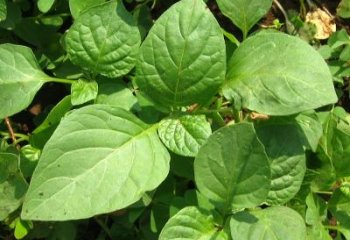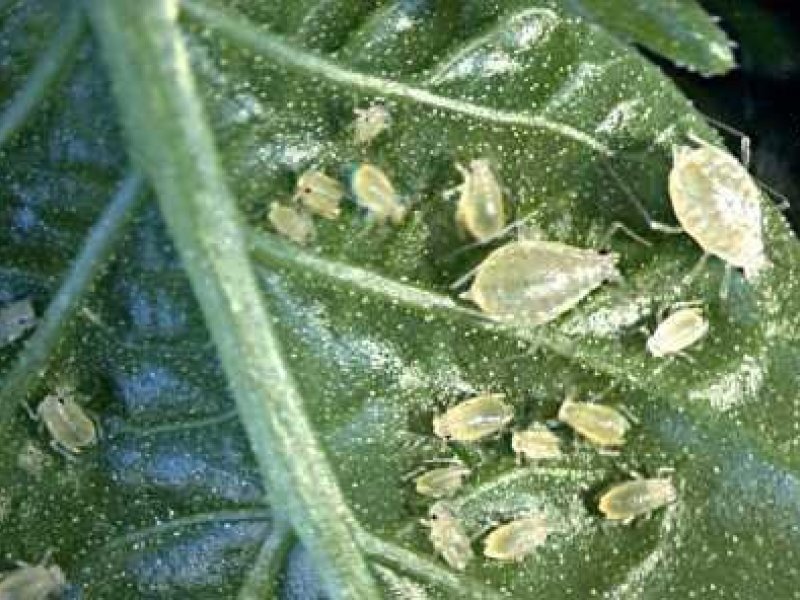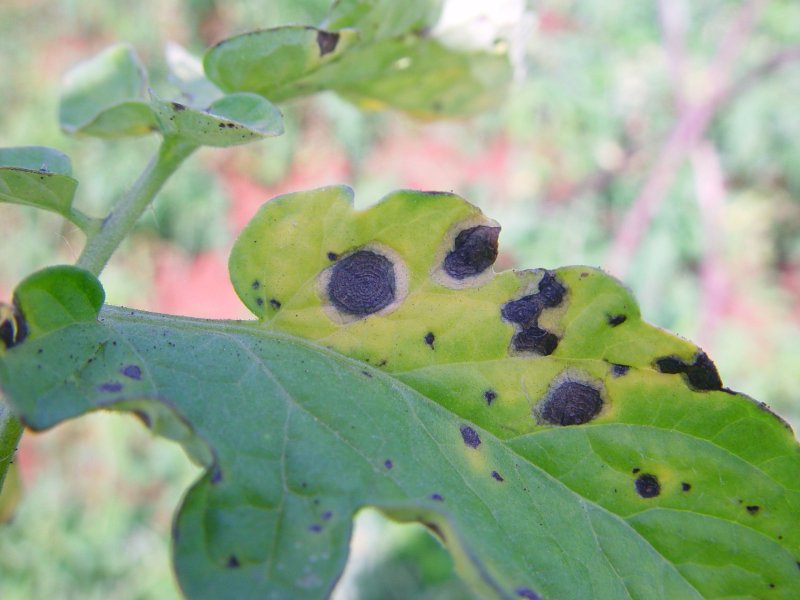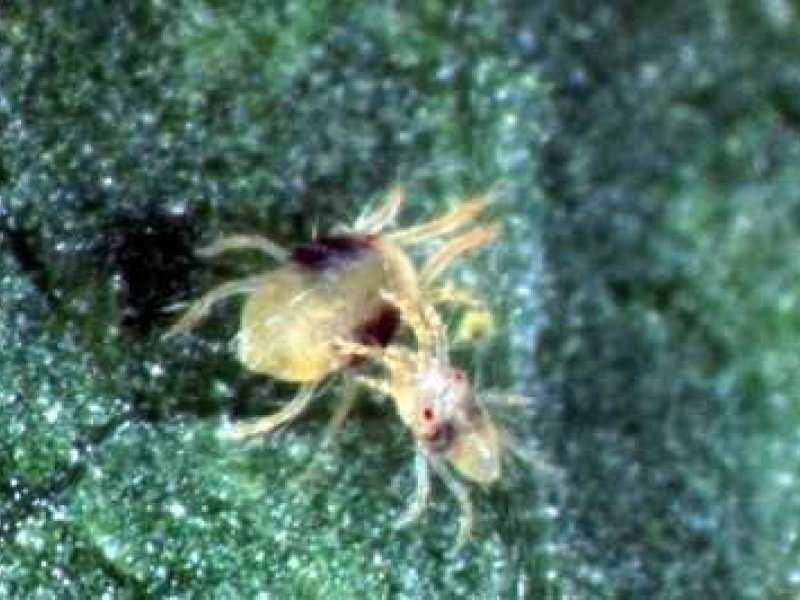|
Aphids (Aphis spp.) Aphids are a major pest, causing leaves to curl and become unattractive to customers. Aphids feed by sucking plant sap. Small aphid populations may be relatively harmless, but heavily infested plants usually have wrinkled leaves, stunted growth and deformed pods. Plants, in particular young plants, may dry out and die under heavy aphid attack. Heavy attack on older plants may cause crop loss by decreasing flower and seed production. Damage may also reduce seed viability. |
|
|
What to do:
|
|
Early blight Leaf spots of early blight are circular, up to 1 cm in diameter, brown, and often show a circular pattern which distinguishes this disease from other leaf spots. Early blight thrives best under warm wet conditions. Leaf spots first appear on the oldest leaves and progress upward on the plant. Entire plant could be defoliated and killed. Controlling early blight once it has established is very difficult. The most important way of controlling early blight is attempting to prevent its establishment and further spread. |
|
|
What to do:
|
|
Spider mites (Tetranychus spp.) The plant's leaves and growth tips are susceptible to mites (very small, sucking arthropods) that result in twisted growth and low productivity. Generally, spider mites feeding may cause reduction in plant growth, flowering, number and length of berries, and number of seeds per berry. Damage is most severe when mites attack young plants. Mite damage may be particularly severe during the dry season.
|
|
|
What to do:
|
Geographical Distribution in Africa
Geographical Distribution of African Nightshade in Africa. Source PROTA. Updated 28 November 2018
Introduction
Narrow-leaved African nightshades, also called mnavu in Swahili, is widely distributed throughout the tropics and can be found throughout East Africa. The plant is an erect, many-branched herb growing 0.5 to 1.0 m high. The plant bears thin, oval, slightly purplish leaves up to 15 cm in length, has numerous white flowers and usually purple to black, round berries about 0.75 cm in diameter containing many small, flattened, yellow seeds.
There are several species with black berries, but the most popular are those with orange berries belonging to Solanum villosum. This group of species is often erroneously referred to as Solanum nigrum, a poisonous plant from Europe that is not usually grown in Africa (AVRDC, 2003).
The leaves are eaten as a cooked vegetable, often mixed with other vegetables and the fresh fruit is also consumed. Some Solanum varieties are preferred for their bitter taste while others are considered 'sweet', particularly after being boiled and the water discarded. The raw leaves contain 4% protein, 6% carbohydrates and are moderately high in vitamin C.
Solanum species that are found in Kenyan and Tanzanian vegetable gardens include S. americanum, S. scabrun and S. villosum.
Solanum plays an important role in traditional medicine in Africa and elsewhere, but the leaves are considered poisonous in some areas of the world so one should be careful about obtaining seeds for planting.

General Information
Climatic conditions, soil and water management
Soils
African nightshades can grow on a wide range of soil types but do not tolerate drought (AVRDC, 2003). African nightshades do well in organic plots.
Agronomic aspects
Propagation and planting
Plants are propagated from seeds. Seeds are marketed by Simlaw Seeds in Nairobi under the name "Black Nightshade" in 25 gram packets.
The soil in the nursery should be loosened and enriched with decomposed manure. Seeds should be mixed with sand and/or ash at a ratio of 1:3 for uniform sowing (AVRDC, 2012). Sow the mixture thinly, either by broadcasting or in rows, 15 - 20 cm apart and cover with a fine layer of soil. After sowing, the bed should be mulched with tall grass or a similar material to retain moisture. This mulch can be removed once the plants are 3 cm. Transplant when seedlings have 6 true leaves and are 10 - 15 cm tall. The spacing should be 20 cm in the row by 40 cm between the rows.
Husbandry
Nightshades require large amounts of nutrients, and therefore do well in soils that are rich in organic matter. They also grow well on land covered with ash from recently burned vegetation (AVRDC, 2003). Apply cattle, chicken or compost manure at a rate of 2-5 kg/m2 depending on availability (AVRDC, 2012). Frequent irrigation is needed for good yields.
Harvesting and post harvest practices
The crop is ready for harvest 4 weeks from transplanting. The stems are cut approximately 15 cm above the ground. This allows new side shoots to develop. Picking is done at weekly intervals.
If complete harvesting is practiced, spacing can be as close as 10 x 10 cm and plants are uprooted. This method is mainly used when there is less than 2 months before the main staple food crop will be planted. Roots of these crops can be kept in water to keep the plants fresh.
Picking should be done very early in the morning and the produce sold the same day. Alternatively, the crop can be harvested late in the afternoon and placed on plastic sheets or banana leaves. These should be tied in small bundles. The flowers should be removed before the crop is taken to market. Water these bundles sparingly to retain freshness.
Post-harvest
Preservation is done by sun-drying. The leaves may be dried and stored for up to one month though this practice greatly reduces the nutritive value and changes the texture.
Medicinal use
African leafy vegetables (ALVs) are rich in mineral nutrients and have medicinal value (Abukutsa-Onyango, 2007). For example, amaranth and African nightshade can be used to feed those people with human immune deficiency virus (HIV/AIDS) since they are both nutritive and therapeutic (Abukutsa-Onyango, 2007). According to Adebooye and Opabode (2004), the vegetables can be used to eliminate malnutrition and promote healthy diets in Africa, through the increased production and consumption. The leaves and seeds provide vitamins A and C, calcium, iron, protein, carbohydrates and lipids (IPGRI, 2003).
Unripe fruits are applied to aching teeth and squeezed on babys’ gums to ease pain during teething (Kajiado, Kitui). Leaves are used for stomach-ache (Machakos). Leaves and fruits are pounded and the extract used for tonsillitis (Machakos). Roots are boiled in milk and given to children as tonic (Maasai) according to Traditional food plants of Kenya (P Maundu et al., 1999).
Nutritional value information and recipes
Selected Recipes
a) Amaranth, spider plant and groundnut relish (contributed by Adija Baraza)
Ingredients:
1/4 kg amaranth (1 large bunch),
2 medium tomatoes, chopped,
1/4 kg spider plant (1 large bunch),
1/2 cup groundnut powder,
2 table spoons shortening or plant oil,
3 table spoons water,
1 medium onion, chopped and
1 tsp salt
Preparation
- Clean and wash both the green vegetables, chop the vegetables, onion and tomatoes and set aside for later use.
- Heat the shortening/plant oil and fry the onion until soft and slightly brown.
- Add the tomatoes, stir and cook until soft.
- Add the green leafy vegetables, stir, cover and simmer for 20 minutes, stirring occasionally.
- Mix the groundnut powder into a smooth paste and add to the simmering vegetables, then salt to taste.
- Cook for an additional 5 minutes.
Preparation yields 4 to 6 small portions and is best served while hot with ugali or mashed bananas.
b) Cream of nightshade spinach (contributed by Mathew K. Kwambai)
Ingredients:
1 kg nightshade leaves,
1 medium tomato, chopped,
1 cup water,
1 tablespoon salt,
90 ml cream (or soymilk),
2 tablespoons vegetable oil and
1 medium onion, chopped
Preparation
- Pinch the leaves of nightshade from the main stalk while retaining a very small leaf stem.
- Wash the leaves in a basin and drain off the water.
- Bring the water to boil and put the leaves into the boiling water for 25 minutes, then remove from fire and drain excess water.
- Heat vegetable oil in a pan and add the chopped onions, stirring occasionally until the onions are soft.
- Add tomatoes and the boiled nightshade leaves and cook for 2 minutes, stirring occasionally.
- Add the cream/soymilk and 1 litre of water, cover and simmer for 5 minutes.
This preparation makes four servings and is best served while hot with ugali.
An alternative recipe involves the addition of 1 to 2 cups of other traditional green vegetables, particularly spider plant or amaranth, with the nightshades.
© FORMAT Kenya
Information on Pests
Pests are similar to those of Solanaceae family (e.g. peppers, potatoes and tomatoes), therefore for more information see also under these crops.
| Aphids are a major pest, causing leaves to curl and become unattractive to customers. Aphids feed by sucking plant sap. Small aphid populations may be relatively harmless, but heavily infested plants usually have wrinkled leaves, stunted growth and deformed pods. Plants, in particular young plants, may dry out and die under heavy aphid attack. Heavy attack on older plants may cause crop loss by decreasing flower and seed production. Damage may also reduce seed viability. What to do:
|
| Spider mites (Tetranychus spp.) The plant's leaves and growth tips are susceptible to mites (very small, sucking arthropods) that result in twisted growth and low productivity. Generally, spider mites feeding may cause reduction in plant growth, flowering, number and length of berries, and number of seeds per berry. Damage is most severe when mites attack young plants. Mite damage may be particularly severe during the dry season.
What to do:
|
Information on Diseases
Diseases are similar to those of Solanaceae family (e.g. peppers, potatoes and tomatoes), therefore for more information see also under these crops.
| Leaf spots of early blight are circular, up to 1 cm in diameter, brown, and often show a circular pattern which distinguishes this disease from other leaf spots. Early blight thrives best under warm wet conditions. Leaf spots first appear on the oldest leaves and progress upward on the plant. Entire plant could be defoliated and killed. Controlling early blight once it has established is very difficult. The most important way of controlling early blight is attempting to prevent its establishment and further spread. What to do:
|
Information Source Links
-
Abukutsa - Onyango, M.O. (2007): The diversity of cultivated African leafy vegetables in three communities in western Kenya. African Journal of Food, Agriculture, Nutrition and Development 7(3):1-15.
-
Adebooye, O., Opabode, J. (2004): Status of conservation of the indigenous leafy vegetables and fruits of Africa. African Journal of Biotechnology (online) 3(12):700-705.
- AVRDC (2003). International Co-operators Guide. Narrow-leaved Nightshade. Biovserity international website. www.avrdc.org
- AVRDC (2012). Simple guide for growing African nightshade. www.avrdc.org
- Edmonds, J.M. and Chweya J.A. (1995). Black nightshades, Solanum Nigrum and related species. Promoting the conservation of underutilized and neglected crops. 15. Gatersleben: IPK/Rome: IPGRI. ISBN 92-9043-321-3 www.bioversityinternational.org
- IPGRI, (1997). Traditional African Vegetables. Promoting the conservation and use of under-utilized and neglected crops. The proceedings of a conference held by the International Plant Genetic Resources Institute (IPGRI), August 1995, ICRAF, Nairobi, Kenya. 171 pp. www.bioversityinternational.org
- IPGRI (2003): Rediscovering a forgotten treasure. IPGRI public awareness. Rome, Italy. http:// ipgr.pa.grinfo.net/index.php. Hemiol. 101.
- Maundu, P.M., Ngugi, G.W. and Kabuye, C.H.S. (1999). Traditional Food Plants in Kenya. Kenya Resource Centre for Indigenous Knowledge. National Museums of Kenya, Nairobi. 270 pp.
- Ministry of Agriculture and Rural Development, Kenya (2000). Local and export vegetables growing manual. Reprinted by Agricultural Information Resource Centre, Nairobi, Kenya.
- Ouma, M.A. Indigenous vegetable production and utilization in Suba district, Kenya: Improving health, unlocking the wealth in Suba district. BioVision - T.T.U, ICIPE. Unpublished.
- PROTA
- Savala, C.E.N., Omare, M.N. and Woomer, P.L. (Eds.). 2003. Organic Resource Management in Kenya: Perspectives and Guidelines. Forum for Organic Resource Management and Agricultural Technologies, Nairobi, Kenya. 184 pp
- Woomer, P.L. (2002). The Traditional Green Vegetable Cookbook. Forum for Organic Resource Management and Agricultural Technologies. Nairobi. 46 pp.
Reference addresses
- Seeds are marketed by Simlaw Seeds in Nairobi under the name Black Nightshade in 25 gram packets. +254 20 2215067/83 www.simlawseeds.co.ke
- Seeds with particularly large, tasty leaves is available from SACRED Africa, Bungoma, Western Kenya.
- Seeds are also available at KALRO Katumani Research Centre, (kalrokatumani@kalro.org; +254 (0) 710 906600).



